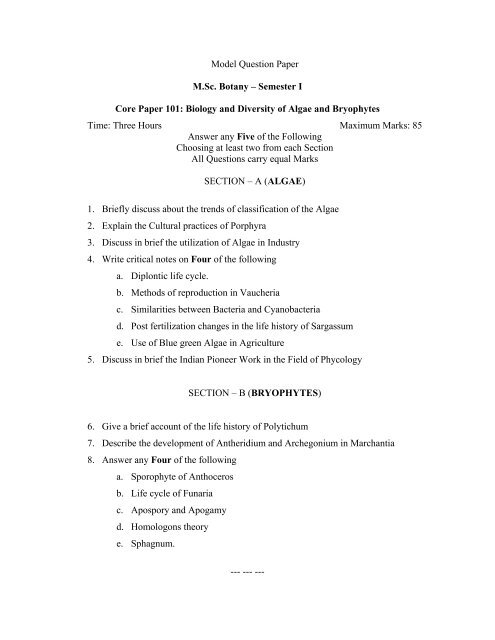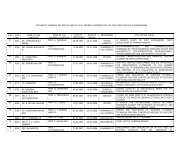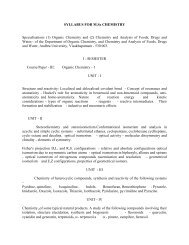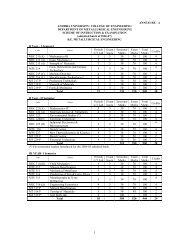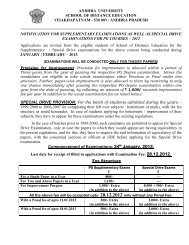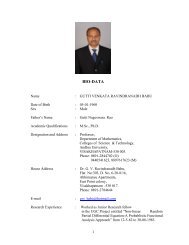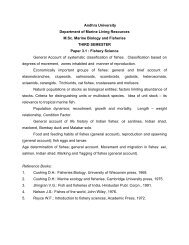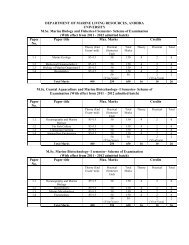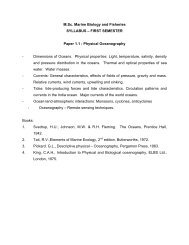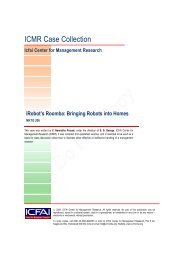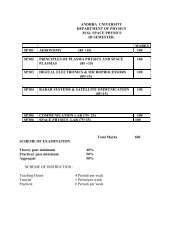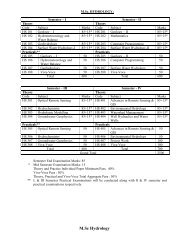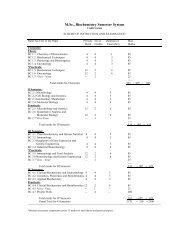Model Question Paper M.Sc. Botany - Andhra University ...
Model Question Paper M.Sc. Botany - Andhra University ...
Model Question Paper M.Sc. Botany - Andhra University ...
Create successful ePaper yourself
Turn your PDF publications into a flip-book with our unique Google optimized e-Paper software.
<strong>Model</strong> <strong>Question</strong> <strong>Paper</strong><br />
M.<strong>Sc</strong>. <strong>Botany</strong> – Semester I<br />
Core <strong>Paper</strong> 101: Biology and Diversity of Algae and Bryophytes<br />
Time: Three Hours Maximum Marks: 85<br />
Answer any Five of the Following<br />
Choosing at least two from each Section<br />
All <strong>Question</strong>s carry equal Marks<br />
SECTION – A (ALGAE)<br />
1. Briefly discuss about the trends of classification of the Algae<br />
2. Explain the Cultural practices of Porphyra<br />
3. Discuss in brief the utilization of Algae in Industry<br />
4. Write critical notes on Four of the following<br />
a. Diplontic life cycle.<br />
b. Methods of reproduction in Vaucheria<br />
c. Similarities between Bacteria and Cyanobacteria<br />
d. Post fertilization changes in the life history of Sargassum<br />
e. Use of Blue green Algae in Agriculture<br />
5. Discuss in brief the Indian Pioneer Work in the Field of Phycology<br />
SECTION – B (BRYOPHYTES)<br />
6. Give a brief account of the life history of Polytichum<br />
7. Describe the development of Antheridium and Archegonium in Marchantia<br />
8. Answer any Four of the following<br />
a. Sporophyte of Anthoceros<br />
b. Life cycle of Funaria<br />
c. Apospory and Apogamy<br />
d. Homologons theory<br />
e. Sphagnum.<br />
--- --- ---
<strong>Model</strong> <strong>Question</strong> <strong>Paper</strong><br />
M.<strong>Sc</strong>. <strong>Botany</strong> – Semester I<br />
Core <strong>Paper</strong> 102: Biology and Diversity of Viruses, Bacteria and Fungi<br />
(Effective from the Admitted Batch of 2009-2010)<br />
Time: 3 Hours Maximum Marks: 85<br />
Answer any FIVE of the following<br />
1. Explain the general characteristics of archaebacteria and cyanobacteria.<br />
2. Give an account on transmission of viruses.<br />
3. What are mycoplasmas? Write any three plant diseases caused by them with<br />
control measures.<br />
4. Write critical notes on any FOUR of the following<br />
a. Plant pathogenic bacteria.<br />
b. Isolation of viruses.<br />
c. Structure and chemistry of viruses.<br />
d. Conjugation in bacteria<br />
e. Diseases caused by fungi in human beings.<br />
5. What are the criteria for fungal classification? Write a brief account of Ainsworth<br />
classification.<br />
6. Give a detailed account on mushroom cultivation<br />
7. What is heterothallism? Explain it with reference to the forms studied by you, in<br />
different classes of fungi.<br />
8. Write critical notes on any FOUR of the following<br />
a. Phylogenic trends in fungi<br />
b. Important characteristics of Basidiomycotina<br />
c. Saprophytic nutrition of fungi<br />
d. Fungi as biocontrol agents<br />
e. Ectomycorrhiza<br />
--- --- ---
<strong>Model</strong> <strong>Question</strong> <strong>Paper</strong><br />
M.<strong>Sc</strong>. <strong>Botany</strong> – Semester I<br />
Core <strong>Paper</strong> 103: Cell Biology of Plants<br />
(Effective from the Admitted Batch of 2009-2010)<br />
Time: 3 Hours Maximum Marks : 85<br />
Answer any FIVE questions . All questions carry equal marks.<br />
1. Explain with suitable examples the special cell types in plants.<br />
2. Give an account of different models of plasma membrane , which model is more<br />
appropriate and why?<br />
3. What is the role of microtubules in cell division?<br />
4. Write short notes on any four of the following:<br />
a. Kinetic energy b. non- covalent interactions c. Protein structure d. Free<br />
energy e. Entropy<br />
5. Explain the role of structural organization of mitochondria in relation to its<br />
function.<br />
6. Give an account on structure and function of Golgi apparatus.<br />
7. What are plasmodesmata? Explain their role in plants.<br />
8. Write short notes on any four of the following:<br />
a. Light microscopy b. NMR c. Freeze fracture technique d. centrifugation<br />
e. ESR<br />
--- --- ---
<strong>Model</strong> <strong>Question</strong> <strong>Paper</strong><br />
M.<strong>Sc</strong>. <strong>Botany</strong> – Semester I<br />
Core <strong>Paper</strong> 104: Cytology and Cytogenetics<br />
(Effective from the Admitted Batch of 2009-2010)<br />
Time: 3 Hours Maximum Marks : 85<br />
Answer any FIVE questions . All questions carry equal marks.<br />
1. Explain with molecular organization of centromeres and telomeres.<br />
2. Give an account of chromosome banding and its applications.<br />
3. What are chromosomal structural aberrations ? Describe meiosis in heterozygotes<br />
for such aberrations.<br />
4. Write short notes on any four of the following:<br />
a. Robertsonian translocation b. Confocal microscopy c. chromosome<br />
microdissection d. Polytene chromosomes e. Nucleosome<br />
5. Describe meiotic behaviour of monosomics. How are they useful in assigning<br />
genes to chromosomes ?<br />
6. Describe meiosis in an autotetraploid.<br />
7. Describe the molecular model of genome organization.<br />
8. Write short notes on any four of the following:<br />
a. Uses of allopolyploids b. Hyperchromicity of DNA c. Primary and secondary<br />
trisomics d. complex structural heterozygotes e. Allotetraploid and<br />
amphidiploid<br />
--- --- ---
<strong>Model</strong> <strong>Question</strong> <strong>Paper</strong><br />
M.<strong>Sc</strong>. <strong>Botany</strong> – Semester II<br />
Core <strong>Paper</strong> 201: Genetics<br />
(Effective from the Admitted Batch of 2009-2010)<br />
Time: 3 Hours Maximum Marks : 85<br />
Answer any FIVE questions . All questions carry equal marks.<br />
1. Explain multiple allelic inheritance and its significance<br />
2. Give an account of three-point testcross method of gene maping.<br />
3. Describe the molecular basis of DNA damage and the repair mechanisms.<br />
4. Write short notes on any four of the following:<br />
a. Correlation of genetic and physical maps. b. Chi-square test for goodness of fit<br />
c. Hollidays model d. Penetrance and expressivity e. sex-influenced characters<br />
5. Describe the organization and importance of Multigene families.<br />
6. Describe the methods of gene mapping in bacteriophages.<br />
7. With the help of one suitable example for each, describe the genetic basis of<br />
mitochondrial and chloroplast related characters.<br />
8. Write short notes on any four of the following:<br />
a. site-directed mutagenesis b. Mechanism of transposition c. Genetic<br />
complementation d. Deletion mapping e. Distinction between cytoplasmic and<br />
nuclear types of inheritance.<br />
--- --- ---
<strong>Model</strong> <strong>Question</strong> <strong>Paper</strong><br />
M.<strong>Sc</strong>. <strong>Botany</strong> – Semester II<br />
Core <strong>Paper</strong> 202: Molecular Biology of Plants<br />
(Effective from the Admitted Batch of 2009-2010)<br />
Time: 3 Hours Maximum Marks : 85<br />
Answer any FIVE questions . All questions carry equal marks.<br />
1. How are carbohydrates classified ? Describe the salient features of their major<br />
categories.<br />
2. Describe the enzymology of DNA replication.<br />
3. Give an account of signal transduction.<br />
4. Write short notes on any four of the following:<br />
a. protein domains and motifs b. types of RNAs c. experimental proof of<br />
Okazaki fragments d. Rolling circle model of replication e. X-ray diffraction<br />
technique.<br />
5. Describe the process of RNA maturation in eukaryotes.<br />
6. Explain how are proteins targeted to various organelles.<br />
7. Describe the mechanism of genetic regulation underlying Lytic and Lysogenic<br />
life cycles.<br />
8. Write short notes on any four of the following:<br />
a. Britten and Davidson’s model b. Gene silencing c. attenuation at trp operon<br />
d. gene imprinting e. translation inhibitors<br />
--- --- ---
<strong>Model</strong> <strong>Question</strong> <strong>Paper</strong><br />
M.<strong>Sc</strong>. <strong>Botany</strong> – Semester II<br />
Core paper 203: Biology and Diversity of Pteridophytes and Gymnosperms<br />
(Effective from the Admitted Batch of 2009-2010)<br />
Time: Three Hours Maximum Marks: 85<br />
Answer any Five of the Following<br />
Choosing at least two from each Section<br />
All <strong>Question</strong>s carry equal Marks<br />
SECTION – A (Pteridophytes)<br />
1. Give details of classification of Pteridophytes along with salient features of each<br />
group<br />
2. Describe the morphology and internal structure of reproductive organs in<br />
Ophioglossum<br />
3. Describe the structure and reproduction in Isoetes<br />
4. Write short notes on any FOUR of the following<br />
a. Siphonostele<br />
b. Sporangia of Gleichenia<br />
c. Sporocarp of Azolla<br />
d. Lepidocarpon<br />
e. Sphenophyllum<br />
SECTION – B (Gymnosperms)<br />
5. Describe the structure and reproduction in Coniferales<br />
6. Write an essay on evolution of Gymnosperms<br />
7. Discuss the variation in the structure of female gametophyte in Gymnosperms<br />
8. Write short notes on any FOUR of the following<br />
a. Cordaitales<br />
b. Lyginopteris<br />
c. Classification of Gymnosperms<br />
d. Endosperm in Gymnosperms<br />
e. Vessel containing Gymnosperm<br />
--- --- ---
<strong>Model</strong> <strong>Question</strong> <strong>Paper</strong><br />
M.<strong>Sc</strong>. <strong>Botany</strong> – Semester II<br />
Core <strong>Paper</strong> 204: Plant Development and Plant Cell, Tissue Culture<br />
(Effective from the Admitted Batch of 2009-2010)<br />
Time: 3 Hours Maximum Marks : 85<br />
Answer FIVE questions.<br />
All questions carry equal marks.<br />
1. Give an account of the organization and development of shoot apex in<br />
different plant groups and the theories associated with them.<br />
2. Describe the structure and development of Vascular cambium.<br />
3. Describe the structural variations met within the secondary phloem in<br />
dicots.<br />
4. Write short notes on any FOUR of the following:<br />
(a) Trichomes.<br />
(b) Laticifers<br />
(c) Lateral roots<br />
(d) Root-microbe interactions<br />
(e) Sieve elements.<br />
5. Write in detail about Plant tissue culture media and add a note on sterilization<br />
techniques.<br />
6. Describe the methods of production of secondary metabolites through tissue culture.<br />
7. Describe methods employed for protoplast isolation and fusion. What are the merits<br />
and demerits of protoplast utilization?<br />
8. Write short notes on any FOUR of the following.<br />
(a) Somatic embryogenesis<br />
(b) Plating efficiency<br />
(c) Cybrids<br />
(d) Cryopreservation<br />
(e) Bioreactors
<strong>Model</strong> <strong>Question</strong> <strong>Paper</strong><br />
M.<strong>Sc</strong>. <strong>Botany</strong> – Semester II<br />
Core <strong>Paper</strong> 205: Medicinal Plants and Ethnobotany<br />
(Effective from the Admitted Batch of 2009-2010)<br />
Time: 3 Hours Maximum Marks : 85<br />
Answer FIVE questions.<br />
All questions carry equal marks.<br />
1. Give a concise account on concept, scope and objectives of ethnobotany.<br />
2. Write an account on major and minor ethnic groups of <strong>Andhra</strong> Pradesh and add a<br />
note on their life styles.<br />
3. Explain the importance of Costus speciosus, Gloriosa superba, Curculigo<br />
orchioides and Pongamia pinnata in ethnomedicinal practices.<br />
4. Write critical notes on any THREE of the following:<br />
(a) Archaeological findings in ethnobotany.<br />
(b) Plants from sacred groves.<br />
(c) Importance of Butea monosperma.<br />
(d) Siddha system of medicine.<br />
(e) Drugs of alkaloids.<br />
5. Write an essay on ethnomedicobotanical research in <strong>Andhra</strong> Pradesh.<br />
6. Give in detail the classification of drugs and explain the analytical methods of<br />
drugs.<br />
7. What is IPR ? Explain the mode of patenting of active principles.<br />
8. Write short notes on any THREE of the following:<br />
(a) Forests of <strong>Andhra</strong> Pradesh.<br />
(b) Medicine importance of Wrightia tinctoria.<br />
(c) Unani system of medicine.<br />
(d) Biological evaluation of drugs.<br />
(e) Natural pesticides.<br />
--- --- ---
<strong>Model</strong> <strong>Question</strong> <strong>Paper</strong><br />
M.<strong>Sc</strong>. <strong>Botany</strong> – Semester III<br />
Core <strong>Paper</strong> 301: Taxonomy of Angiosperms and Plant Resources Utilization and<br />
Conservation<br />
(Effective from the Admitted Batch of 2009-2010)<br />
Time: 3 Hours Maximum Marks : 85<br />
Answer any Five <strong>Question</strong>s<br />
1. Give an account of International Code of Botanical Nomenclature.<br />
2. Discuss Embryological evidences in relation to Taxonomy.<br />
3. Give an out line of Cronquist system of classification. Discuss merits and demerits.<br />
4. Write short notes on any Two of the following:<br />
A) Sub species<br />
B) Amentiferae<br />
C) Cladistic analysis<br />
D) GIS<br />
5. Write an essay on plant biodiversity and give its significance.<br />
6. Write an essay on the origin of agriculture.<br />
7. Describe the origin, evolution, cultivation practices and use of sugarcane.<br />
8. Write a short notes on any four of the following:<br />
a) HYV’s of wheat<br />
b) Plant introduction<br />
c) Cytogenetics of Sorghum<br />
d) Indian cotton<br />
e) Benefits of Green revolution<br />
f) Medicinal importance of Catheranthus<br />
----------------
<strong>Model</strong> <strong>Question</strong> <strong>Paper</strong><br />
M.<strong>Sc</strong>. <strong>Botany</strong> – Semester III<br />
Core <strong>Paper</strong> 302: Plant Reproduction<br />
(Effective from the Admitted Batch of 2009-2010)<br />
Time: 3 Hours Maximum Marks : 85<br />
Answer FIVE questions.<br />
All questions carry equal marks.<br />
1. Write an essay on the ultra structure of tapetum and its functions.<br />
2. Describe the process of male gametophyte development.<br />
3. Give an illustrated account of the different types of tetrasporic embryo sacs you<br />
have studied.<br />
4. Write short notes on FOUR of the following:<br />
(a) Pollen pistil interaction.<br />
(b) Embryo sac haustoria<br />
(c) Ultra structure of synergid.<br />
(d) Obturator.<br />
(e) Pollen embryo sacs.<br />
5. Describe the different methods used to overcome incompatability.<br />
6. Describe the endosperm haustoria you have studied and add a brief note on the<br />
functions of the endosperm.<br />
7. Write a critical essay on Apomixis with suitable examples and give the<br />
significance of apomixis.<br />
8. Write short notes on FOUR of the following:<br />
(a) Polyspermy.<br />
(b) Endosperm in Cocos nucifera<br />
(c) Double fertilization.<br />
(d) Embryo development in monocots.<br />
(e) Adventive embryony<br />
--- --- ---
<strong>Model</strong> <strong>Question</strong> <strong>Paper</strong><br />
M.<strong>Sc</strong>. <strong>Botany</strong> – Semester III<br />
Core <strong>Paper</strong> 303: Plant Ecology<br />
(Effective from the Admitted Batch of 2009-2010)<br />
Time: 3 Hours Maximum Marks : 85<br />
Each question carries equal marks<br />
Answer any Five of the following questions<br />
1. Describe the synthetic characters of Plant communities.<br />
2. Give a detailed account of structure and functions of Indian forest ecosystem.<br />
3. Write an essay on major vegetational types of India with suitable examples.<br />
4. Write short notes on any three<br />
a) Ecological niche<br />
b) Growth curves<br />
c) Age distribution<br />
d) Autogenic and allogenic succession<br />
e) Climax communities<br />
5. Define pollution and discuss the details of water pollution<br />
6. Illustrate the Global biodiversity status monitoring different and documentation.<br />
7. Write an account of different Natural resources and through a light on<br />
conservation.<br />
8. Write short notes on any three<br />
a) Green house gases and global environmental changes<br />
b) Phosphorous cycle<br />
c) Solid state pollination<br />
d) Index of dominance<br />
e) Trophism and standing state<br />
----------
<strong>Model</strong> <strong>Question</strong> <strong>Paper</strong><br />
M.<strong>Sc</strong>. <strong>Botany</strong> – Semester III<br />
Core <strong>Paper</strong> 304: Plant Physiology<br />
(Effective from the Admitted Batch of 2009-2010)<br />
Time: 3 Hours Maximum Marks : 85<br />
Answer any Five <strong>Question</strong>s<br />
All questions Carry equal marks<br />
1. Define water potential? Describe its components and their interrelationships in<br />
plant cells.<br />
2. What is Brassinonolid? Discuss the biosynthetic pathway of Brassinosteroids.<br />
3. Differentiate biotic and abiotic stress and explain the effects of various stresses on<br />
morphological, anatomical and biochemical changes in plants.<br />
4. Write short notes on any FOUR of the following.<br />
a) Heat shock Proteins<br />
b) SPAC concept<br />
c) Root microbe interactions<br />
d) Zinc deficiency in plants<br />
e) Photomorphogenesis<br />
5. Describe the mechanisms of electron and proton transport structure, synthesis and<br />
function of ATP.<br />
6. Describe the mechanism of mineral ion uptake by plants.<br />
7. Write a detailed account on C3, C4 and CAM plants in relation to physiological<br />
and ecological considerations.<br />
8. Write short notes on any FOUR of the following.<br />
a) C4 Varients<br />
b) Photorespiration<br />
c) Isozymes<br />
d) Water oxidizing complex<br />
e) β-Oxidation<br />
---------
<strong>Model</strong> <strong>Question</strong> <strong>Paper</strong><br />
M.<strong>Sc</strong>. <strong>Botany</strong> – Semester III<br />
Core <strong>Paper</strong> 305: Principles of Genetic Analysis<br />
(Effective from the Admitted Batch of 2009-2010)<br />
Time: 3 Hours Maximum Marks : 85<br />
Answer any FIVE questions . All questions carry equal marks.<br />
1. Explain multiple allelic inheritance and its significance<br />
2. Give an account of three-point testcross method of gene maping.<br />
3. With the help of suitable examples explain the pattern of inheritance of<br />
quantitative characters..<br />
4. Write short notes on any four of the following:<br />
a. Correlation of genetic and physical maps. b. Chi-square test for goodness of fit<br />
c. Pedigree chart d. Penetrance and expressivity e. LOD score<br />
5. What is DNA fingerprinting ? How is it done ? What are its applications ?<br />
6. Describe the methods of gene mapping in bacteriophages.<br />
7. What is eugenics ? Explain with suitable examples how genetic analysis can help<br />
to improve human population?<br />
8. Write short notes on any four of the following:<br />
a. Selection media b. Tetrad analysis c. Hardy-Weinberg Law d. Genetic<br />
complementation e. sex-influenced characters<br />
--- --- ---
<strong>Model</strong> <strong>Question</strong> <strong>Paper</strong><br />
M.<strong>Sc</strong>. <strong>Botany</strong> – Semester IV<br />
Core <strong>Paper</strong> 401: Genetic Engineering of Plants and Microbes<br />
(Effective from the Admitted Batch of 2009-2010)<br />
Time: 3 Hours Maximum Marks : 85<br />
Answer any Five questions. All questions carry equal marks.<br />
1. What are restriction enzymes? What is their role in rDNA technology?<br />
2. Distinguish between Northern and Southern blot techniques.<br />
3. Give an account on applications of rDNA technology to Agriculture with success<br />
stories.<br />
4. Write short notes on any two of the following:<br />
a.) YACS b.) cDNA library c.) RAPD d) Isoschizomers e) non-radioactive<br />
labeling<br />
5. What is Microarray technique? Explain the principles and applications.<br />
6. What are genome projects? Explain the advantages of genomic projects<br />
.<br />
7. Explain the genetic basis of nitrogen fixation as revealed through rDNA technology.<br />
8. Write short notes on any three of the following:<br />
a.) Patents b.) Phylogenic trees c.) Expression vectors d.) Blue white selection of<br />
recombinants e) Proteomics<br />
--- --- ---
<strong>Model</strong> <strong>Question</strong> <strong>Paper</strong><br />
M.<strong>Sc</strong>. <strong>Botany</strong> – Semester IV<br />
Core <strong>Paper</strong> 402: Evolution and Plant Breeding<br />
(Effective from the Admitted Batch of 2009-2010)<br />
Time: 3 Hours Maximum Marks : 85<br />
Answer any FIVE questions . All questions carry equal marks.<br />
1. What is molecular evolution ? Explain.<br />
2. Describe the various types of natural selection.<br />
3. Give an account of the origin of cultivated plants<br />
4. Write short notes on any four of the following:<br />
a. Miller’s experiment b. Industrial melanism c. QTL analysis d. Conditions for<br />
Hardy-Weinberg equilibrium e. Synthetic theory.<br />
5. Describe the methods of breeding self-pollinated crops.<br />
6. Describe the properties of Binomial distribution. Explain the steps in fitting<br />
binomial distribution to a sample data.<br />
7. Distinguish between Regression and Correlation. Explain the steps in arriving at<br />
the regression equation.<br />
8. Write short notes on any four of the following:<br />
a. 2 X 2 contingency table b. Types of errors c. Introgressive segregation d.<br />
Heterosis e. Standard deviation.<br />
--- --- ---
<strong>Model</strong> <strong>Question</strong> <strong>Paper</strong><br />
M.<strong>Sc</strong>. <strong>Botany</strong> – Semester IV<br />
Elective <strong>Paper</strong>: Advanced Cytogenetics.<br />
(Effective from the Admitted Batch of 2009-2010)<br />
Time: 3 Hours Maximum Marks : 85<br />
Answer any FIVE questions . All questions carry equal marks.<br />
1. Draw neat labeled diagrams to indicate the consequences of crossing overs in<br />
different positions of inversion heterozygotes.<br />
2. Explain how are the chromosomes involved in translocation heterozygotes and<br />
their break points identified ?<br />
3. Describe the methods of production of haploids . What is the importance of<br />
haploids ?<br />
4. Write short notes on any four of the following :<br />
a) Interchromosomal effects b) Role of inversions in evolution<br />
c) A-B translocations d) Preferential fertilization e) Effects of b-chromosomes<br />
on chiasma frequency<br />
5. Distinguish between autotetraploids and amphidiploids. How is homeologous<br />
chromosome pairing regulated ?<br />
6. Explain the mechanisms of sex determination.<br />
7. Describe the major steps involved in chromosome walking and jumping.<br />
8. Write short notes on any four of the following:<br />
a) RIL b) YACS c) Genetic basis of Apomixix d) gene segregation in ta<br />
duplex plant e) Drosera – type pairing.<br />
--- --- ---
<strong>Model</strong> <strong>Question</strong> <strong>Paper</strong><br />
M.<strong>Sc</strong>. <strong>Botany</strong> - Semester IV<br />
Elective <strong>Paper</strong>: Applied Phycology<br />
(Effective from the Admitted Batch of 2009-2010)<br />
Time: 3 Hours Max. Marks: 85<br />
Answer any FIVE <strong>Question</strong>s<br />
All <strong>Question</strong>s carry equal marks<br />
1. Describe the structure, reproduction and life cycle of Gelidium.<br />
2. Give detailed cultivation of Algae which are used for production of Agar-Agar<br />
and Algin.<br />
3. Discuss the role of Algae in water pollution.<br />
4. Write short notes on any FOUR of the following:<br />
a) Algae as Biofertilizers<br />
b) Terrestrial Algae<br />
c) Chlorella<br />
d) Cyclotella<br />
e) Dunaliella<br />
5. Give a detailed account of the economic importance of Algae.<br />
6. Desscribe the composition, distribution and phytoplankton of Indian waters.<br />
Add a note on sampling techniques of phytoplankton.<br />
7. Discuss the role of Algae in sewage disposal and waste land reclamation.<br />
8. Write short notes on any FOUR of the following:<br />
a) Culture of Spirulina<br />
b) Algae and Aquaculture industry<br />
c) Agar-Agar<br />
d) Nostoc<br />
e) Toxic Algae<br />
--------
<strong>Model</strong> <strong>Question</strong> <strong>Paper</strong><br />
M.<strong>Sc</strong>. <strong>Botany</strong> - Semester IV<br />
Elective <strong>Paper</strong>: Plant Pathology<br />
(Effective from the Admitted Batch of 2009-2010)<br />
Time: 3 Hours Max. Marks: 85<br />
Answer any FIVE <strong>Question</strong>s<br />
All <strong>Question</strong>s carry equal marks<br />
1. Describe the infection phenomena of plant pathogens. Also discuss the factors<br />
affecting the infections.<br />
2. Discuss different methods of control of plant diseases.<br />
3. Discuss the role of enzymes in plant diseases.<br />
4. Write short notes on any FOUR of the following:<br />
a) Damping off of seedling<br />
b) Powdery mildew of cucurbits<br />
c) Tikka disease of ground nut<br />
d) Dispersal of plant pathogens<br />
e) Post harvest diseases<br />
5. Give symptoms, etiology, epidemiology of blast disease of Rice, Citrus canker<br />
and Brown rot of Potatoes.<br />
6. Write an essay on viral plant diseases, pathogens involved, their diagnosis and<br />
control.<br />
7. Discuss the defence mechanism against plant pathogens in plants.<br />
8. Write short notes on any FOUR of the following:<br />
a) Phytotoxins<br />
b) Development of resistant varieties<br />
c) Host resistance against plant pathogens<br />
d) Ergot of Bajra<br />
e) Whip smut of Sugarcane<br />
--------
<strong>Model</strong> <strong>Question</strong> <strong>Paper</strong><br />
M.<strong>Sc</strong>. <strong>Botany</strong> - Semester IV<br />
Elective <strong>Paper</strong>: Plant Biosystematics<br />
(Effective from the Admitted Batch of 2009-2010)<br />
Time: 3 Hours Max. Marks: 85<br />
Answer any FIVE <strong>Question</strong>s<br />
All <strong>Question</strong>s carry equal marks<br />
1. Give an account of the history, scope, importance and objectives of Plant<br />
Biosystematics.<br />
2. Give a critical account of the aims and scope of transplant experiments in<br />
Biosystematics.<br />
3. Write an account of the advantages of self and cross pollination mechanisms in<br />
breeding programmes.<br />
4. Write short notes on any FOUR of the following:<br />
a) Geographical and regional variation<br />
b) Coenospecies<br />
c) Isolating mechanisms<br />
d) Phenotypic plasticity<br />
e) Significance of protogyny<br />
5. Discuss the role of cytological findings and comment on their significance in<br />
the field of Plant Biosystematics.<br />
6. Write critically on the contribution of Phytochemistry in Biosystematics.<br />
7. Present a critical account of ‘Biological concept’ of a species.<br />
8. Write short notes on any FOUR of the following:<br />
a) Taximetrics<br />
b) Leaky isolation barriers<br />
c) Catastrophic selection<br />
d) Polyploidy<br />
e) Seratotaxonomy<br />
--------
<strong>Model</strong> <strong>Question</strong> <strong>Paper</strong><br />
M.<strong>Sc</strong>. <strong>Botany</strong> - Semester IV<br />
Elective <strong>Paper</strong>: Agricultural Biotechnology<br />
(Effective from the Admitted Batch of 2009-2010)<br />
Time: 3 Hours Max. Marks: 85<br />
Answer any FIVE <strong>Question</strong>s<br />
All <strong>Question</strong>s carry equal marks<br />
1. What are artificial seeds? Describe the method of their production and uses.<br />
2. Write a detailed account on anther culture and discuss its significance in crop<br />
improvement.<br />
3. Describe the technique of embryo culture and explain its usage in plant breeding<br />
programmes.<br />
4. Explain the molecular basis of plant breeding.<br />
5. What are biopesticides? Discuss their role in present day context.<br />
6. Give an account of specific integrated pest management practices followed for<br />
Cotton.<br />
7. What are Mutagens? Describe their mode of action at the Molecular level.<br />
8. Write short notes on any FOUR of the following:<br />
a) Transversions<br />
b) Protoplast fusion<br />
c) Clones<br />
d) Biological control of pests<br />
e) Terminator gene technology<br />
--------
<strong>Model</strong> <strong>Question</strong> <strong>Paper</strong><br />
M.<strong>Sc</strong>. <strong>Botany</strong> - Semester IV<br />
Elective <strong>Paper</strong>: Experimental Embryology of Angiosperms<br />
(Effective from the Admitted Batch of 2009-2010)<br />
Time: 3 Hours Max. Marks: 85<br />
Answer any FIVE <strong>Question</strong>s<br />
All <strong>Question</strong>s carry equal marks<br />
1. Write an account on the basic techniques in tissue culture.<br />
2. Discuss the various expeimental methods for the production of haploids. Add a<br />
note on the cytology of androgenesis.<br />
3. Write short notes on any FOUR of the following:<br />
a) Media for pollen germination<br />
b) Intra ovarian pollination<br />
c) Nucellus culture<br />
d) De-differentiation<br />
e) HEPA filters<br />
4. Describe the events involved in pollen-pistil interaction. Add a note on the role<br />
of in vitro fertilization in overcoming incompatibility.<br />
5. What is parthenocarpy? Describe the methods of induction of parthenocarpy<br />
and indicate its significance in horticulture.<br />
6. What physiological aspects are involved in the development of endosperm and<br />
embryo? Indicate the role of endosperm in embryo development.<br />
7. What is meant by cell hybridization and protoplast fusion? Describe the<br />
methods used in sorting the fused products.<br />
8. Write short notes on any FOUR of the following:<br />
a) Nucellar polyembryony<br />
b) Casein hydrolysate<br />
c) Pellicle<br />
d) Nurse endosperm<br />
e) Totipotency<br />
--------
<strong>Model</strong> <strong>Question</strong> <strong>Paper</strong><br />
M.<strong>Sc</strong>. <strong>Botany</strong> - Semester IV<br />
Elective <strong>Paper</strong>: Crop Physiology and Biotechnology<br />
(Effective from the Admitted Batch of 2009-2010)<br />
Time: 3 Hours Max. Marks: 85<br />
Answer any FIVE <strong>Question</strong>s<br />
All <strong>Question</strong>s carry equal marks<br />
1. Describe different components, their nature and organization of Photosystem I<br />
and Photosystem II in plants.<br />
2. Explain the molecular biology of water stress tolerance in plants.<br />
3. Write short notes on any FOUR of the following:<br />
a) C4 plants<br />
b) Photorespiration<br />
c) Source-sink relationships<br />
d) Succulence under salt stress<br />
e) Heat shock proteins<br />
4. Discuss the techniques of gene transfer in plants.<br />
5. Give an account of genetic manipulation of crops for insect resistance.<br />
6. Briefly describe the genetic engineering of seed proteins and oils.<br />
7. What is polymerase chain reaction? Discuss its applications.<br />
8. Write short notes on any FOUR of the following:<br />
a) Micropropagation<br />
b) Protoplast isolation<br />
c) Pathogen-derived resistance<br />
d) Herbicide resistance<br />
e) DNA microarray technology<br />
--------


